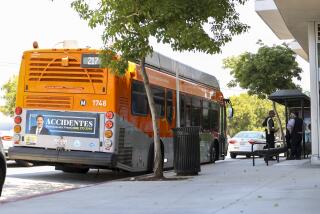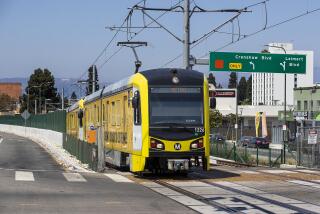Placentia to Hush Train Horns
- Share via
City officials in Placentia, where screaming train horns have been an irritant for years, announced Tuesday that work would begin soon on a $7-million project to improve grade crossings and prohibit engineers from sounding their horns as they rumble through town.
Project officials said that several key developments have cleared the way for construction of Placentia’s so-called quiet zone, one of the first plans in the nation to silence train horns along an urban rail line.
Work could begin in December at eight major streets in Placentia, Anaheim and on county land, making it unnecessary for engineers to sound a warning at railroad crossings. About 70 freight and passenger trains pass through the city daily.
The quiet zone calls for street improvements, medians and so-called quad-gates, designed to prevent motorists from trying to cross the tracks and beat the train.
The announcement marks a bright spot in the city’s contentious effort to eliminate the nuisance that residents and city leaders believe the rail lines have become.
The $450-million OnTrac project, which would lower the rail lines into a trench, has lurched along slowly, draining city resources and leaving Placentia deeply in debt. Some doubt that the project will ever be completed.
The much smaller quiet-zone project got a boost in August when $3.4 million in federal funds were approved for the work. Based on two bids received this month, the city is planning to select a contractor by late November.
Project officials said installation of some of the safest crossing gates available could be finished as early as March.
“This is the culmination of over three years of work,” said Placentia Mayor Judy A. Dickinson. “Cities throughout the nation will be able to use this project as a model.”
She appeared at a news conference and public ceremony to mark recent progress in the quiet zone project. Local, state and federal officials attended the event, including Assemblywoman Lynn Daucher (R-Brea) and Reps. Gary Miller (R-Diamond Bar) and Edward R. Royce (R-Fullerton).
The ceremony near the Kraemer Boulevard grade crossing was marred by three passing freight trains that sounded off as they approached. Houses line one side of the tracks; an apartment complex is on the other.
“Every 10 or 20 minutes, they blast their horns,” said Glenn Rice, a retired mail carrier who lives in a mobile home park near the tracks. “When I talk to my sister or son on the telephone, we have to stop our conversations. Everyone is sick of it.”
The quiet zone is part of the city’s OnTrac project to place five miles of railroad tracks into a concrete trench and build 11 overpasses for surface streets that cross it.
Planners say the project will improve rail safety, help revitalize downtown Placentia and accommodate the growth of train traffic to and from the ports of Los Angeles and Long Beach. Projections indicate that by 2010, 135 trains a day will use the north Orange County rail corridor.
The work will be done at Kraemer Boulevard, Orangethorpe Avenue, Rose Drive, Jefferson Street, Van Buren Street, Richfield Road, Lakeview Avenue and Kellogg Drive.
Critics of the OnTrac project questioned whether the quiet zone was necessary, if the trench or overpasses and underpasses could be built at some or all the streets in the years ahead.
“If we build the trench or the overpasses, we won’t need these quad gates and we could waste $7 million,” said activist Greg Sowards, who is running for city treasurer in Tuesday’s election.
City Councilman Chris Lowe said the quiet zone was a short-term solution to a long-standing problem. Something needs to be done, he said, because OnTrac might not receive adequate federal funding. “Things are up in the air right now,” Lowe said. “We need to have another solution for the time being.”
Critics also were suspicious of the timing of the quiet zone ceremony, held a week before city elections. Community activists opposed to OnTrac are backing a slate of candidates to unseat Dickinson and Councilman Scott P. Brady, two staunch OnTrac supporters.
“They could have built the quiet zone two years ago, but OnTrac has spent the money on high-priced consultants,” said Craig Green, a founder of Citizens for a Better Placentia, which has questioned the project’s expenses and management.
More to Read
Sign up for Essential California
The most important California stories and recommendations in your inbox every morning.
You may occasionally receive promotional content from the Los Angeles Times.











